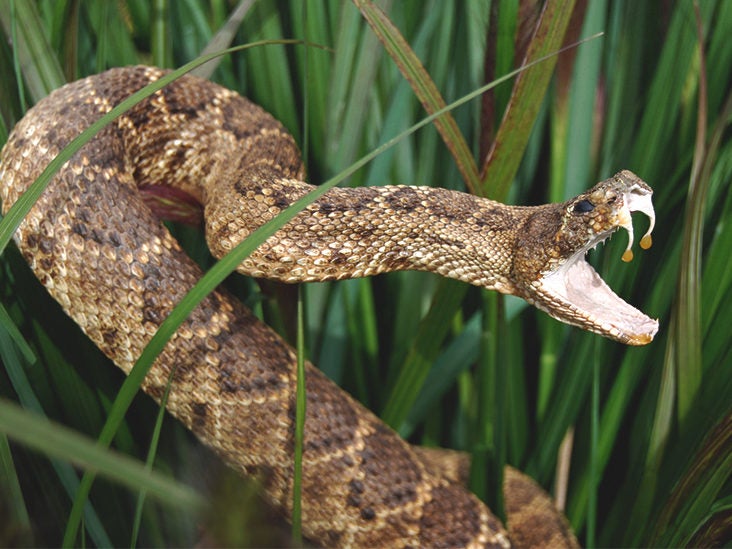Rattlesnakes are one of the most feared creatures on the planet. Their venomous bites can lead to severe pain, swelling, and even death. But what exactly does rattlesnake venom do to the human body? In this article, we will explore the effects of rattlesnake venom and how it can impact our health.
From paralysis to organ failure, rattlesnake venom can wreak havoc on the human body. But there’s more to it than just physical symptoms. Rattlesnake venom can also affect our mental health and overall well-being. So, let’s dive into the world of rattlesnake venom and discover what it’s capable of.
Rattlesnake venom is a complex mixture of proteins and enzymes that can cause a range of symptoms in humans. The venom can lead to tissue damage, bleeding disorders, and even death. The severity of the symptoms depends on the amount of venom injected and the location of the bite. Treatment typically involves antivenom medication and supportive care.

What Does Rattlesnake Venom Do?
Rattlesnake venom is a complex mixture of proteins, enzymes, and other molecules that can cause a range of effects on the human body. It is a potent poison that is designed to immobilize or kill prey, but it can also be dangerous to humans if they are bitten by a venomous snake. In this article, we will explore the different ways that rattlesnake venom can affect the human body.
1. Local Effects of Rattlesnake Venom
When a person is bitten by a rattlesnake, the venom can cause a range of local effects at the site of the bite. These effects can include pain, swelling, and redness. The venom can also cause tissue damage, such as necrosis, which is the death of cells and tissues. In severe cases, this can lead to the loss of limbs or other body parts.
The local effects of rattlesnake venom can be treated with antivenom, which is a substance that is designed to counteract the effects of the venom. Antivenom is made by injecting a small amount of venom into an animal, such as a horse, and then harvesting the antibodies that the animal produces in response. These antibodies can then be purified and used to treat snakebite victims.
2. Systemic Effects of Rattlesnake Venom
In addition to the local effects of rattlesnake venom, it can also cause a range of systemic effects throughout the body. These effects can include nausea, vomiting, dizziness, and weakness. The venom can also affect the cardiovascular system, causing changes in blood pressure, heart rate, and rhythm.
In severe cases, rattlesnake venom can cause respiratory failure, which can be life-threatening. This occurs when the muscles that control breathing become paralyzed. If a person is experiencing respiratory distress after a snakebite, they should seek medical attention immediately.
3. Composition of Rattlesnake Venom
The composition of rattlesnake venom can vary depending on the species of snake. However, most rattlesnake venoms contain a mixture of proteins, enzymes, and other molecules that can cause a range of effects on the human body.
Some of the most common components of rattlesnake venom include hemotoxins, which can cause bleeding and tissue damage, and neurotoxins, which can affect the nervous system and cause paralysis. Other components of rattlesnake venom can affect the cardiovascular system, the immune system, and the kidneys.
4. Benefits of Rattlesnake Venom
Despite its harmful effects on humans, rattlesnake venom has some potential benefits. Researchers are currently exploring the use of rattlesnake venom in medicine, particularly in the treatment of cancer.
Some components of rattlesnake venom have been found to have anti-cancer properties. For example, a protein called crotoxin, which is found in the venom of the South American rattlesnake, has been shown to be effective against certain types of cancer cells. Researchers are also exploring the use of rattlesnake venom in pain management and as a potential treatment for neurological disorders.
5. Venomous vs. Non-Venomous Snakes
It is important to be able to distinguish between venomous and non-venomous snakes in order to avoid being bitten. Venomous snakes, such as rattlesnakes, copperheads, and cottonmouths, have distinctive features that can help you identify them. They have triangular-shaped heads, vertical pupils, and heat-sensing pits on their faces.
Non-venomous snakes, such as garter snakes and corn snakes, have round heads, round pupils, and no heat-sensing pits. They are generally harmless to humans and can even be kept as pets.
6. First Aid for Snakebites
If you are bitten by a snake, it is important to seek medical attention immediately. However, there are some steps you can take to provide first aid before help arrives.
The first step is to try to identify the snake, if possible. This can help medical professionals determine the appropriate treatment. You should also try to keep the affected limb immobilized and at or below the level of your heart. This can help slow the spread of venom throughout your body.
7. Antivenom Treatment for Snakebites
Antivenom is the primary treatment for snakebites. It is a substance that is designed to counteract the effects of the venom. Antivenom is administered intravenously and works by binding to the venom molecules and neutralizing them.
Antivenom can be highly effective in treating snakebites, but it can also have side effects. Some people may experience an allergic reaction to the antivenom, which can be life-threatening. For this reason, antivenom should only be administered in a medical setting by trained professionals.
8. Prevention of Snakebites
The best way to prevent snakebites is to avoid contact with snakes. This means staying away from areas where snakes are known to live, such as tall grass, brush, and rocks. You should also wear protective clothing, such as boots and long pants, when you are in snake-prone areas.
If you do encounter a snake, it is important to give it plenty of space and avoid provoking it. Snakes will generally try to avoid contact with humans, but they may bite if they feel threatened.
9. Common Myths about Snakebites
There are many myths and misconceptions about snakebites that can lead to dangerous behavior. One common myth is that sucking out the venom can help. In reality, this can actually make the situation worse by causing more tissue damage and spreading the venom.
Another myth is that cutting the wound and applying a tourniquet can help. Again, this can actually make the situation worse by causing more tissue damage and preventing the venom from circulating throughout the body.
10. Conclusion
Rattlesnake venom is a complex mixture of proteins, enzymes, and other molecules that can cause a range of effects on the human body. It is a potent poison that can be dangerous to humans if they are bitten by a venomous snake. However, with proper treatment and prevention measures, the risk of snakebites can be minimized. If you do encounter a snake, the best course of action is to give it plenty of space and seek medical attention immediately if you are bitten.
Frequently Asked Questions
Here are some commonly asked questions about rattlesnake venom and its effects.
What are the symptoms of a rattlesnake bite?
When a rattlesnake bites, its venom can cause a variety of symptoms. These may include:
- Severe pain at the site of the bite
- Swelling and redness around the bite
- Nausea and vomiting
- Blurred vision
- Difficulty breathing
If you suspect you have been bitten by a rattlesnake, seek medical attention immediately.
How does rattlesnake venom affect the body?
Rattlesnake venom contains a variety of toxins that can affect the body in different ways. Some toxins can cause damage to the tissues around the bite, while others can affect the nervous system or the circulatory system.
One of the most dangerous effects of rattlesnake venom is its ability to disrupt blood clotting, which can lead to internal bleeding. In severe cases, this can be life-threatening.
Can rattlesnake venom be fatal?
While many people are able to recover from rattlesnake bites with proper medical treatment, the venom can be fatal in some cases. The risk of death is highest in individuals who do not seek treatment or who have an allergic reaction to the venom.
It is important to remember that not all rattlesnake bites are the same. The severity of the bite will depend on factors such as the size and species of the snake, the amount of venom injected, and the location of the bite.
How is rattlesnake venom treated?
Treatment for a rattlesnake bite will depend on the severity of the symptoms. In most cases, the affected limb will be immobilized and the person will be given antivenom to counteract the effects of the venom.
Other treatments may include pain relievers, IV fluids to prevent dehydration, and antibiotics to prevent infection.
Is it possible to build up a tolerance to rattlesnake venom?
Some individuals who work with rattlesnakes on a regular basis may develop a tolerance to the venom over time. However, this is not a recommended method of protection from snake bites.
Even if you have developed a tolerance to rattlesnake venom, it is important to still exercise caution around these animals and take steps to avoid being bitten.
How Does Snake Venom Work? | World’s Worst Venom | Spark
In conclusion, rattlesnake venom is a complex mixture of proteins and enzymes that can have a range of effects on the human body. These effects can include pain, swelling, and tissue damage, as well as potentially life-threatening symptoms such as cardiovascular collapse and respiratory failure.
Despite the risks associated with rattlesnake bites, it is important to remember that these snakes play an important role in their ecosystems and should be respected rather than feared. By understanding the function of rattlesnake venom and taking appropriate precautions when in snake habitat, we can coexist with these fascinating creatures and appreciate their unique place in the natural world.
Overall, the study of rattlesnake venom is a fascinating and ongoing field of research, with potential applications in medicine, agriculture, and even national security. By continuing to explore the mechanisms and effects of this venom, we can gain a deeper understanding of the natural world and potentially uncover new treatments and therapies for a range of human ailments.


